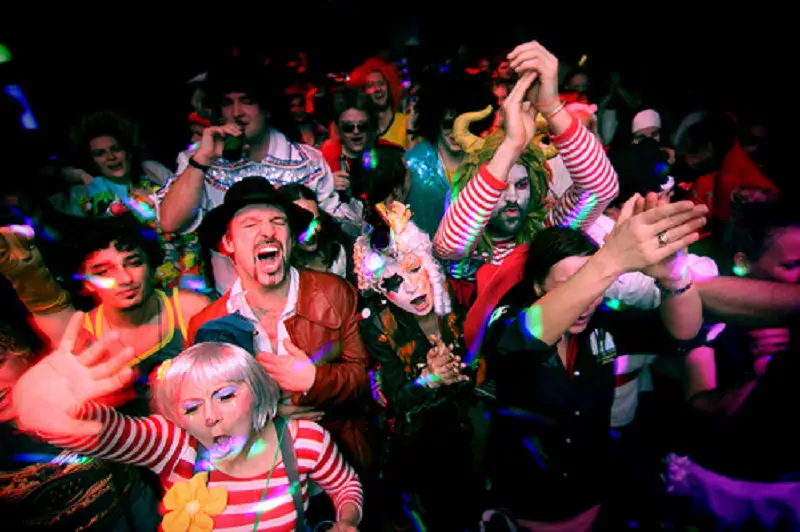While contagion literally means “through touch” and is commonly used to explain the spread of diseases, in communication, it means the social transmission, by contact, of ideas, culture and behaviours. It assumes that social transmission can occur from mere touch or contact with culture. Contagion theory talks about collective behavior of human beings. Members of a group act similarly as crowd behavior as people have a habit of following crowd. Communication is also done in the form of a collective behavior, as a mass of people believe in the same things and react similar too. Crowds are supposed to create a hypnotic effect on people which spreads from one person to another.
The contagion theory was proposed at first by Gustave Le Bon through a research and a book based on the research called “The Crowd: a Study of Popular Mind in France” which was published in 1885. He expressed contagion effect on social and political opinions. He just explained crowd influence but not crowd’s influence on individuals, which was later added by Robert Park and Herbert Blumer. The theory says that ideas or behavior transfers through and from his network and can be unreasonable and inconsistent for a brief amount of time. The effect again goes away if the person leaves the crowd.

Concepts in Contagion Theory
People act as a contagion basically to avoid individual responsibility and adopt a mass behavior. According to Gustave, individuals are influenced and their behavior turns into absurd, violent and sadistic due to the nature of crowd behavior. The demotion of behavior cannot be controlled as individuals feel anonymous and do not have to think about the aftereffects. People get group feeling and cease to think personally. They are unaware of their own behavior in a crowd, their inhibitions become minimum and they become willing to sacrifice for others.
Similarly, Robert Park transformed the theory and added factors like the human tendency to mimic and support which made the theory more practical. People also have a tendency to attach to a group when in stress and reflect collective actions where any person can act as a leader.
Herbert Blumer also talked about contagion theory and added a term “milling” to it which means a period of time when people reply consciously and spontaneously. There is less action due to external provocations in milling. It decreases individual behavior and actions, increasing impossible behavior.
The contagion behavior can have exceptions and exclusions. But, mostly, it happens due to internal human mechanisms and states like avoidance of conflict, conformity, etc. which cannot be avoided easily.
Contagion theory is similar to many other communication and social theories like Symbolic Interaction Theory, Gatekeeping Theory, Hypodermic Needle Theory, Network Theory, Cartesian Rational Action Theory, etc. as they are related to social construction of reality.
There are two types of contagion- contagion by cohesion and contagion by structural equivalence. Contagion by cohesion is the influence from direct communication to perceptions whereas contagion by structural equivalence is due to similar communication patterns or structure of communication network. Common contagion behavior are deliberate self-harm, rule violation, aggression, hysterias, financial and consumer behavior contagions.

Features of Contagion Theory
- Crowd takes a life of its own and is not affected by individual feelings.
- Mass has its own emotions and behavior unlike individual behavior.
- Contagion promotes irrational behavior as people lose their inhibitions.
- Individuals do not possess individual identity while in a group.
- Any person can act as a leader who influences all.
- Crowd can either be organized or spontaneous.
- Crowd communication is mostly irrational and stupid.
- Individuals do not get a chance to communicate their personal morals and feelings.
- Beliefs, attitudes and assumptions also become similar.
- Communication, attitude and behavior are infectious which is known as contagion.
- Factors that define the extent of influence are strength, frequency, complexity and asymmetry.
- Network influences relation between members of network or crowd.
- The effect does not only pass to people present in a particular time or place.
Examples of Contagion Theory
- If a people interested in country music goes to a rock concert along with friends and the friends are enjoying very much, the person will start to enjoy too due to group feeling and mass contagion. The person forgets his/her own likes and dislikes to follow the group behavior.
- If a presenter involves and engages the audience, the person acts like a leader and can make people act like he/she wishes to.
- Similarly, if some people start whistling during any performance, many others will follow the act even though the individuals might not believe in whistling morally as a behavior standard. If a crowd is quiet, other people also feel awkward to create any kind of noise.
- A group of protesters start throwing bricks and other things as people are not afraid when there are many other people doing the same thing.
Similarly, people need not be in the same place or time to have contagion feelings. A tragic book called “The Sorrows of Young Werther” by Johann von Goethe caused mass suicide effect across Europe in the 18th century. The semi-autobiographical novel was banned for more than a century due to the imitate group suicide it was causing to the people who read the book. Suicide acted as an infection or contagion.

Criticisms of Contagion Theory
- The theory does not have much theoretical implications explained. It is mostly based on empirical evidence.
- Contagion is taken as an infection which is uncontrollable.
- There is a debate on contagion to be conscious (deliberate imitation or prior motivations) or unconscious behavior (uncertainty).
- Imitation is taken as a human nature and contagion its natural extension.
